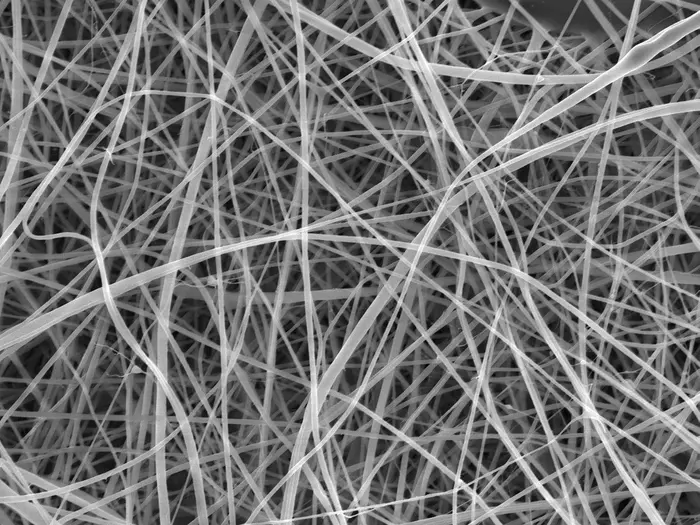The world’s thinnest spaghetti—about 200 times thinner than a human hair—has been created by a research team led by University College London. But do not get ready to boil it for dinner just yet—this spaghetti is not destined for the kitchen. Instead, these ultra-thin strands, known as nanofibers, could have a big impact on medicine and industry.

Each individual strand is too narrow to be clearly captured by any form of visible light camera or microscope, so the team used a scanning electron microscope, scanning the mat with a focused beam of electrons and creating an image based on the pattern of electrons that are deflected or knocked-off. Image Credit: Beatrice Britton / Adam Clancy
Nanofibers made from starch—a natural substance produced by most green plants to store excess glucose—hold huge potential for medical applications. These nanofiber mats are highly porous, allowing water and moisture to pass through while blocking bacteria, making them ideal for wound dressings. They can also serve as scaffolding for bone regeneration and enable targeted drug delivery.
However, producing nanofibers typically requires extracting and purifying starch from plant cells, a resource-intensive process that consumes large amounts of energy and water.
The UCL research team proposes a greener alternative: creating nanofibers directly from a starch-rich ingredient like flour, commonly used in pasta-making.
In a recent Nanoscale Advances paper, the team details how they created ultra-thin spaghetti-like fibers just 372 nanometers (billionths of a meter) wide using a process called electrospinning. This technique involves pulling threads of a flour-and-liquid mixture through the tip of a needle using an electric charge. The innovative work was led by Beatrice Britton as part of her master’s degree in chemistry at UCL.
To make spaghetti, you push a mixture of water and flour through metal holes. In our study, we did the same except we pulled our flour mixture through with an electrical charge. It’s literally spaghetti but much smaller.
Dr. Adam Clancy, Study Co-Author and Lecturer, Department of Chemistry, University College London
In their paper, the researchers compare their creation to su filindeu (“threads of God”), a traditional handmade pasta from the town of Nuoro in Sardinia. Considered the thinnest known pasta before this study, su filindeu measures about 400 microns wide—roughly 1,000 times thicker than the new electrospun spaghetti. At just 372 nanometers, the novel nanofibers are even narrower than some wavelengths of light, representing a remarkable leap in precision and scale.
Nanofibers, such as those made of starch, show potential for use in wound dressings as they are very porous. In addition, nanofibers are being explored for use as a scaffold to regrow tissue, as they mimic the extra-cellular matrix – a network of proteins and other molecules that cells build to support themselves.
Gareth Williams, Study Co-Author and Professor, University College London
Dr Clancy added, “Starch is a promising material to use as it is abundant and renewable – it is the second largest source of biomass on Earth, behind cellulose – and it is biodegradable, meaning it can be broken down in the body. But purifying starch requires lots of processing. We have shown that a simpler way to make nanofibers using flour is possible. The next step would be to investigate the properties of this product. We would want to know, for instance, how quickly it disintegrates, how it interacts with cells, and if you could produce it at scale.”
“I don’t think it’s useful as pasta, sadly, as it would overcook in less than a second, before you could take it out of the pan,” Williams stated.
In the electrospinning process, a needle containing the mixture and a metal plate act as the two ends of a battery. When an electrical charge is applied, the mixture completes the circuit by streaming out of the needle and depositing onto the metal plate, forming nanofibers.
Using a starch-rich ingredient like white flour for electrospinning presents unique challenges compared to pure starch. The impurities in flour, such as protein and cellulose, increase its viscosity, making it more difficult to form fibers.
To address this, the researchers combined flour with formic acid instead of water. The formic acid effectively breaks apart the large stacks of starch helices, which are otherwise too bulky to serve as nanofiber building blocks. Interestingly, this process mimics how cooking breaks down starch, making pasta digestible. As the noodle forms and travels through the air toward the metal plate, the formic acid evaporates.
To achieve the ideal consistency for spinning, the mixture was carefully warmed over several hours and then gradually cooled—a process requiring meticulous adjustments to ensure optimal fiber formation.
I really enjoyed the iterative process of adjusting the variables and observing how this changed the mixture. It was a lot of trial and error – I didn’t think I would form fibers but I did. Thank you to Adam and Gareth for being so helpful and ready to answer the questions I had.
Beatrice Britton, Study Lead Author, University College London
Journal Reference:
Britton, B. et. al. (2024) Nanopasta: electrospinning nanofibers of white flour. Nanoscale Advances. doi.org/10.1039/D4NA00601A